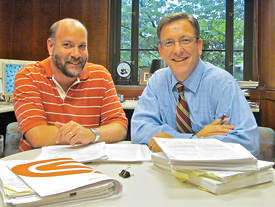A training grant that initially was awarded to the School of Dentistry in 1976 — and now encompasses other units on campus — is about to approach its 40th anniversary.
“This grant is the glue that will unite the research efforts of many here at the School of Dentistry as well as the Medical School and the College of Engineering in the growing fields of tissue engineering and regenerative medicine,” says Dr. David Kohn as he discusses an important training grant that was recently renewed for the dental school by the National Institutes of Health.

Drs. David Kohn, left, and Paul Krebsbach review the application for the NIH research grant. Photo by Jerry Mastey.
Kohn, a professor of dentistry and a professor of biomedical engineering at the College of Engineering, is a co-principal investigator and director of the training program whose federal funding is designed to jump start the research careers of doctoral students and post-docs working in the fields of tissue engineering and regenerative medicine. The other co-principal investigator is Dr. Paul Krebsbach, the Roy H. Roberts Professor of Dentistry, chair of the School of Dentistry’s Department of Biologic and Materials Sciences, and professor of biomedical engineering.
When the $6 million, five-year training grant expires in 2017, Kohn says it will mark the anniversary of the longest-funded training grant awarded by the National Institute of Dental and Craniofacial Research. It is one of the two longest-standing training grants awarded to U-M.
“By using these funds in a collaborative endeavor at the three units at the University of Michigan, we can bring together a large number of faculty and Ph.D. or post-doctoral students who can work together more effectively,” Kohn says. “This will represent a significant change since much of the work now being done is by individual investigators or small groups of investigators.”
The collaborative effort, known as TEAM (Tissue Engineering at Michigan), will provide an interdisciplinary research-intensive environment for 17 trainees annually who wish to pursue careers in tissue engineering and regeneration with a focus on restoring oral-craniofacial tissues. Five of the 17 trainees will be dual-degree DDS/Ph.D. students from the School of Dentistry; seven will be PhD students from dentistry, medicine and engineering; and five will be students pursuing post-doctoral training. Thirty mentors from the representative schools will supervise the trainees.
The financial support for the TEAM effort will enable the trainees, who are just beginning their academic and research careers, to gather preliminary data that will not only lead to new discoveries, but also serve as a springboard for their individual careers and future funding. Trainees will be selected based on strong academic records, recommendation letters and a commitment to a research career focused on oral science, with an emphasis on tissue engineering and regeneration.
“The training grant is an all-encompassing initiative, from basic research to translational research and, ultimately, patient-based care. However, patient-based therapies that may emerge will probably be some time away,” Kohn says. “But we want to use the university’s strengths in basic science research, engineering materials and design, and clinical research to discover new ways to help patients whose tissues and organs have been lost or significantly damaged because of trauma, pathology or congenital abnormalities.” Research will be conducted at the School of Dentistry, the Medical School, the College of Engineering and the North Campus Research Center.
“Because of the longevity of this research training grant for nearly four decades, we have been successful in training both clinicians and non-clinicians, and have consistently been able to develop leaders with solid credentials who are extensively involved in academic dentistry,” Kohn says. He noted that during the past four decades “over 100 trainees have participated in this research training program and, as a result, nearly two-thirds have held faculty positions, and about one-third have been department heads or program directors.”

